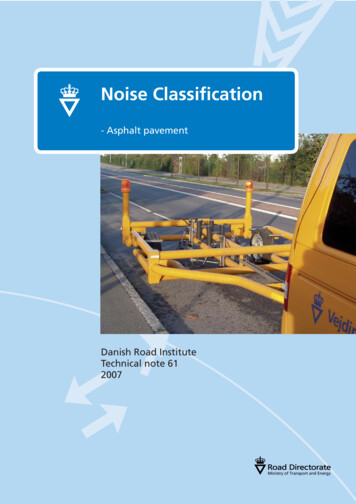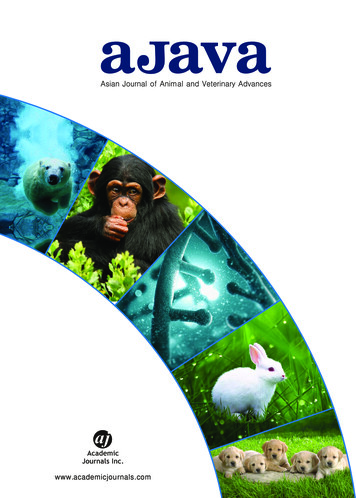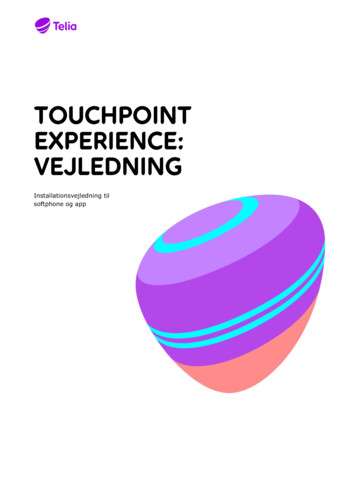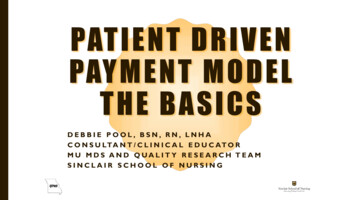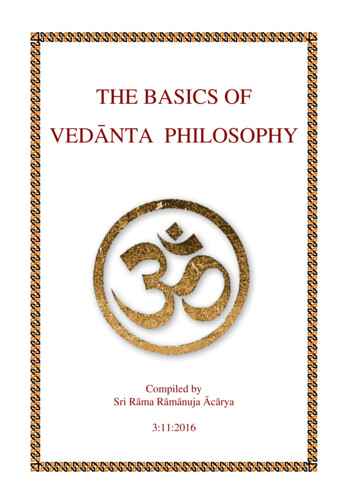
Transcription
THE BASICS OFVEDĀNTA PHILOSOPHYCompiled bySri Rāma Rāmānuja Ācārya3:11:2016
2THE VEDĀNTATHE Vedānta system of philosophy is the heart of modern Hinduism which is properlyknown as sanātana dharma — the “Eternal Path”.This system of philosophy1 commonly referred to as the Vedānta — composed of Veda knowledge and Anta end; literally refers to “the end of the Vedas or final conclusion ofknowledge”.The corpus of the Vedas2 consist of four major divisions3 the last sections of each Veda arethe texts known as the Upanishads and their central topic of investigation is the Ground ofBeing, or Ultimate Reality called Brahman4.The Vedānta is technically classified as Uttara-Mimāmsa. Uttara means "last''; Mimāmsameans "investigation, examination, discussion, or consideration"; therefore, the UltimateConclusion of the Vedas.1. DEVELOPMENT OF THE VEDĀNTA5Concept of God in the VedasThe Rig Veda is the root text upon which the other Vedas depend. The Rig consist ofhymns to different deities i.e. Agni, Mitra, Varuna, Indra and so on.The hymns were used in Sacrifices (yajñas) in which oblations of clarified butter and othersubstances were offered into the sacrificial fire.These devas were conceived of as the Principalities underlying and governing the differentphenomenon of nature, such as fire, sun, wind, rain etc., on which life itself, agriculture,and prosperity depended.Nature, though presided over by different devas, is subject to the cosmic law (called Rta),which regulates the whole world, the laws and processes of nature and all living beings.In the hymns of the Veda (sūktas) each of these devas was praised and extolled with thesame epithets and declared to be ‘the Supreme’.Although the Vedic religion appears to bepolytheistic in its approach, there is a peculiarityin that each of the many gods is praised andextolled as the Supreme Being, the Creator of theuniverse and the Lord of all the Gods etc.monotheism belief in One God.polytheism belief in many gods.atheism belief in no God.agnosticism suspension of belief in a god.henotheism election of one among many godsas supreme.pantheism everything is God.The portfolios of cosmic management were also not unique to one deva only as in Greekmythology, but were reallocated according to the devotion of the poet.1From the outset it is important to note that English terms do not do justice to the Sanskrit terms.“Philosophy” is a poor translation of darshana — which means a view of Reality and includes philosophy,theology and spiritual practice.2The ancient collections of Hymns in Sanskrit dating back more than 5000 years3Samhita, Brāhmaṇa, Araṇyaka and Upaṇiṣad.4Brahman must not be confused with Brahmin which is the priestly caste.5(Adapted from Introduction to the Upanishads by Dr. Radhakrishnan)
3Max Muller who was one of the first western scholars to translate the Vedic hymns, coinedthe term 'Henotheism' to differentiate the Vedic attitude from simple polytheism.Henotheism means that one god is elevated above all other gods to the post of SupremeBeing.In the Rig Veda we come across many passages where it is clearly stated that the differentdevas/gods are only manifestations of one Ultimate Reality called by various names suchas Agni, Yama etc.ekam sad viprā bahudhā vadanti. .The Truth is ONE but the wise describe it in various waysMany scholars have postulated a clear development in Vedic thought.!The idea of God gradually evolved from simple polytheism through henotheism, toreach its culmination in monotheism.!This hypothesis may be true but henotheism is not merely a transitionalphenomenon.!Indian monotheism even in its most developed form, retains the belief that thoughthe Godhead is one, it has limitless manifestations in the many devas, anyone ofwhich may be worshipped as a form of the Supreme Godhead.Even today in India, we have five divergent cults of the Śaivism, Vaiṣṇavism, Śāktaism,and the Gānapatya and Saurya cults. All flourishing side by side but all based on aphilosophy of one Supreme Godhead of which all other forms are also manifestations.Indian monotheism in its living forms, from the Vedic age till now, has always believed inunity of the gods in the Godhead.In Rig Veda, the belief in this fundamental unity of all gods is only a part of a greatertheology which can be more clearly learnt from the famous Puruṣa-sūkta.The Puruṣa-sūkta (Rig Veda 10.90) reveals that all existence i.e. wealth, heavens, planets,gods, living and non-living objects are the parts of one great Being (Puruṣa), who pervadesthe perceptible world, but also stands beyond it. In Him all that is, has been and will be, areunited.The poetic insight of the hymn, not only indicates that the universe is one organic whole,but that the Supreme Being is both immanent and transcendent (God pervades the world,yet He is not exhausted, thereby, He remains also beyond it).In Western Theology, this concept is called panentheism (pan–all, en–in, theos–God) notpantheism — that is, all is not equal to God, but all is in God, who is greater than all.This one hymn, reveals a variety of ideals that inspired the Vedic mind; monism,panentheism and organic symbiosis of the world.In another hymn of Nāsadīya Sūkta (Rig Veda 10.120), we come across the concept of theImpersonal Absolute. Here, the reality underlying all existence; the primal One, fromwhich everything originates cannot be described it says, either as nonexistent or as existent(na asat, no sat). It is the concept of the Indeterminate Absolute, which is the realityunderlying all things, but is in Itself indescribable.
4When we try to establish the relationship between the idea of the Ultimate Reality as aPerson and the concept of it as an Indeterminate Absolute, we find that even in thedescription of the Ultimate Reality as a Personal Being, there is mention of its transcendentaspect, which cannot be described in terms of the objects we perceive in the world.Both Personal and Impersonal are conceived here as the two aspects of the same Reality.HYMN OF CREATIONRig Veda. Mandala 10 Hymn 129There was not the Non-existent nor the Existent then;there was not the air nor the sky which is beyond.What did it contain?Was there water, unfathomable and profound ?There was not death nor immortality then.There was not the beacon of the night nor of day.That One Being breathed, airless by its own power.Other than That, there was nothing whatsoever.Darkness was in the beginning hidden by darkness;indistinguishable, all this was surging.That which, coming into being, was enveloped by the void,that One arose through the power of combustion.Desire in the beginning came upon That,that [desire] was the primal seed born of mind.Sages seeking in their hearts with wisdom,discovered the connection of the existent in the non-existent.They have extended their measuring cord across the void;but was there ‘above’ or was there ‘below’?there were Seminal Powers, there were mighty forces,there was energy below and there was impulse above.Who truly knows? Who shall here declare,whence it has been produced, whence this material universe?The gods came after the emergence of the universe.Who then knows whence it has arisen.Whence this vast material universe has arisen,and whether ‘He’ founded it or not;He, who in the highest heaven is its Surveyor;He alone knows, or perhaps He knows not.Most of the important foundational principles of the Vedānta are found in Rig Veda butthey have been presented through poetry.The Sanskrit word for a poet — Kavi also means a sage, a seer or a visionary.The method by which the sages arrived at these views, their reasoning and the argumentsput forth in support of them, are not found in the Vedic texts themselves. Thus there is nosystematic philosophical methodology to be found in the Samhita portion of the Vedas. Allattempts at a systematic philosophical investigation are to be found in the latter sections of
5the Vedas known as the Upaniṣads, where questions about ātman, Brahman and the cosmosare raised and discussed at length.Some of the Upaniṣads are written in verse and they follow the pattern of the hymns of theRig Veda, while others, though written in prose, also lack the support of cogentphilosophical reasoning. Some of them are in the form of dialogues where propositions arepresented and supported by arguments.Existential Problems of the Upaniṣads What is Self (ātman)? What is the Supreme Reality (Brahman)? What is the Source from which all things originate, by which all live and into which all dissolve? What is that by knowing which everything can be known? What is that by knowing which the unknown becomes known? What is that by knowing which one can attain immortality?These questions in themselves are indicative of the fundamental belief of the Indian scholars thatthere is an all-pervasive Reality underlying all things; from which they arise, in which they existand into which they ultimately all return. And that there is some Reality by knowing whichimmortality or cessation of suffering can be attained.2. SCRIPTURAL SOURCES OF VEDĀNTAThe Vedānta is based upon 3 scriptural sources known as Prasthāna Trayam:—1. Upaṇiṣads2. Bhagavad Gītā3. Brahma-sūtrasThe last sections of each Veda are the texts known as the Upaniṣads and their central topicof investigation is the Ground of Being, called Brahman. These are the sources for all thedoctrines taught in Vedānta.The Gītā is a portion of the epic Mahābhārata and is a dialogue between Krishna andArjuna as reported by Sañjaya. It is considered to be a summary of all the Upaṇiṣads.The principle text of Vedānta is the Brahma-sūtra. Tradition attributes this work to oneBādarāyāṇa6 whose actual date is unknown. The dates given range from 500 B.C.E. to aslate as 200 C.E.6Some scholars contend that Bādarāyāṇa is an alias for Vyāsa, the celebrated mythical sage who is regardedas the one who originally compiled the Vedas, the Mahābhārata, the Purāṇas, and other portions of Hindusacred literature as well as the Vedānta-sūtras; but the title Vyāsa ("compiler”) seems to have been given toany great compiler or author.
63. THE ORIGIN AND DEVELOPMENT OF VEDĀNTA-SŪTRASThe many different Upaniṣads evolved from the various Vedic schools at different timesand places. They often seem to contradict each other in the way they tackle variousexistential problems, and their conclusions were frequently ambiguous, if not diametricallyopposed. Hence, there arose an urgent need to systematise the different teachings and bringout the harmony underlying them.Bādarāyaṇa was the first to address this problem and in his work — the Brahma-sūtra heattempted to set forth the unanimous teachings of the Upaniṣads and defended them againstthe possible and actual objections raised.He wrote in the sūtra style, which is terse and cryptic and thus created the need for thevarious commentaries which were written by various scholars. Each of the commentatorstried to justify his position as the only one consistent with the revealed texts, (śrutis) andsūtras.The author of each of these bhāṣyas (commentaries) thus became founder of a particularschool of Vedānta and thus we have the schools of Saṅkara, Rāmānuja, Madhva, Nimbārkaand many latter day variations such as the school of Aurobindo.4. EPISTEMOLOGY (THE THEORY OF KNOWLEDGE)There are 3 ways of acquiring knowledge which are:—1. Direct perception and experience through the five senses. (pratyakṣa)2. Rational thought, reasoning, (anumāna)3. Trustworthy testimony from an objective witness. (āpta-vākya or śabda)Think of crime investigators — when they arrive on the scene they take note of all theevidence at the scene, they photograph, measure and document everything.They then return to the precinct and draw up a time-line, paste up pictures, and try to figureout a logical narrative of events and possible causes and culprits.They then call in trustworthy witnesses and take their testimonies – comparing the variousversions to the evidence and the logical time-line.Now, in relation to our examination of the presented esoteric Truths of Vedānta, the aboveorder has to be inverted.1. The metaphysical propositions of Vedānta are trans-personal and are based entirelyupon Scripture (śruti “that which is heard” i.e. the Upaṇiṣads) and hence areconsidered ‘trustworthy’ testimony. We study the texts in order to gain knowledgeabout metaphysical Truths that is unobtainable by the usual means.2. Rational thought can help us in our study by ensuring that we remain within thebounds of reason and indeed all the propositions of Vedānta are vigorouslydefended by the use of logic and debate.3. By the assimilation and the application of the teachings, direct personal realizationcan be achieved. Once we have studied the teachings and subjected them to the testof logic we then need to apply them in practice. Direct experience is the ultimatetest of the teachings of Vedānta.
75. THE DIDACTIC PROCESSThus the didactic or learning process consists of 3 phases:–1. Śravana — attentive listening to the teachings (śabda).There is very little “objective” listening to anything! Our listening is conditioned by3 factors which should be taken into account by the teacher when instructing thestudents — all doctrines, rules and regulations are conditioned by:—svabhāva — One’s personality and disposition.bhūmika — The level of intellectual, academic and spiritual attainment.adhikāra — The capacity of each individual for comprehension and insight andthe ability to actually put the teachings into practice2. Manana — reflection upon what has been heard.Reflection using reason and logic must be applied to all the teachings. Nothing should beaccepted unexamined.There are four criteria which are applied to test the validity of the teaching which can beapplied to all schools of thought:—Satyam — is the teaching logical, rational, reasonable and does it stand up tochallenge and debate. Can it be effectively defended from opposing views?Śivam — is the teaching universally beneficial? Does it benefit me personally —will I be improved through this teaching? Does it benefit the majority? Does itbenefit all beings, sentient and insentient?Sundaram — is the teaching aesthetical, does it contribute to culture and to theArts? Does it create more beauty in the world? Does it enhance people’s lives?Śānti — Does the teaching contribute to universal peace and tranquility? Isharmony produced between people and with nature and the other sentient beings?3. Nididhyāsana — contemplation upon the teachings and their assimilation.This stage of the process has two aspects: — śraddhā7 — development of conviction that the practice and application of theteaching will lead to the results in mind. This conviction should be grounded onlogic and supported by reason. If one is not yet convinced one returns to the aforementioned processes and to the teacher for further interrogation and clarification. Prayojana — the application of the teaching through meditation and practice. Theonly way to realise the goal is abhyāsa or regular and consistent application andpractice.śaṅkarācārya defines śraddhā as:— śāstrasya guru-vākyasya satya-buddhyavadhāraṇam sā śraddhākathitā sadbhir-yayā vastūpalabhyate Śraddhā is an sound intellectual understanding of the words of thegurus and scriptures whereby tangible goals can be achieved.7
86. METHODOLOGY OF VEDĀNTAA fundamental concept of philosophy (which means the ‘love of knowledge’) is that wemust develop and keep an open mind!If we are sincere in our investigation of the Truth; we are intellectually obliged to examinethe teachings of all those who lay claim to the “Universal Truth”; we, as objective lovers ofthe Truth should ascertain wherein they are all in accord, for this is likely to be theUltimate Truth. Where they differ, we are privileged to have our own opinion.Differences in theology/philosophy arise due to various personal perspectives conditionedby hereditary, demographic and socio-economic factors and differing stages of personaldevelopment and training.The same Truth and Teaching therefore will vary according to three factors:—svabhāva — One’s personality and dispositionbhūmika — The level of intellectual and spiritual attainmentadhikāra — The capacity of each individual for insight.All ideas and concepts are accepted as a step forward; no ideation is evaded or discarded.However, no dogma is accepted as conclusive, since the Truth is revealed afresh with eachindividual who attains enlightenment.Vedānta is an on-going process of practice and realization. It is passed on through asuccession of spiritual teachers (gurus) each of who has their own personal take on theteachings and presents it to the students in a fresh narrative.The Vedānta is a system which investigates, analyses, and criticizes all theories alike,forcing every proposition to verify and substantiate itself according to the rules of logic.Before studying Vedānta one was required to have a good grasp of Mīmāṁsa(Hermeneutics) — the rules of interpretation of texts, and Nyāya — logic and debate.7. PERSONAL PRACTICE & DEVELOPMENT.One of the principals of Indian philosophy is that there must be a practical application ofknowledge8.Knowledge (jñāna) goes hand-in-hand with spiritual practice (sādhana).The technicalities of Spiritual Practice are handled differently in each of the schools but tostart off with we’ll present the format of the biggest school which is Advaita.The study of the Sacred Texts however profound, will at best, provide only a generalknowledge which will help to refine the mind and incline one towards personal attainmentof knowledge of the Ultimate Truth (Brahma-vidya).8Rāmānuja defines valid knowledge as — yathāvasthita vyavahārāṇuguṇa jñānam pramā— validknowledge is that which reveals a thing as it really is and is applicable to the interests of daily life.
9Nevertheless, doubts will continue to rise and uncertainty will still remain, anddetermination and conviction (sraddhā) will falter; therefore, Bādarāyāṇa contends that itis necessary to study the Vedānta in order to have these doubts permanently removed. Alsothe tendency of an untrained mind is to forget, and therefore, until conviction arises,repeated study is necessary.The discipline of Vedānta fortifies the mind with the necessary arguments and rationalismto help us avoid believing in false doctrines until we grow firm in our understanding andexperience direct Self-realization (ātma-bodha).Self-realization is a matter of unfoldment not of attainment. The pre-requisite for wisdomis the removal of certain negative and afflictive emotions and concepts, and the cultivationof the right disposition through the performance of Dharma, from study and associationwith those who are wise and are, therefore, capable of guiding us toward the ultimate goal.We shall discuss spiritual practice in the last chapter.Disagreements Between The Schools of Vedānta.The chief metaphysical problem on which the three major schools of the Vedānta differ, isthe nature of, and the relation between the ātman (Self) and Brahman (Supreme Being)and between Brahman and the world.BrahmanjīvātmanFjagatSome, like Madhva, hold the Dualist (Dvaita) view that they are absolutely separate andothers like Saṅkara hold that the two are absolutely identical, this view is known as'Advaita' (Non-dual).Some others, like Rāmānuja, again hold that the two are related like part and whole; thisview may be briefly called Viśiṣṭādvaita (qualified non-dualism).There were many other views, each specifying a particular type of identity (abheda),difference (bheda) or identity in difference (bhedābheda) between the jīva and Brahman,but the three prominent schools of Vedānta are those of Saṅkara, Rāmānuja andMādhavācārya.
108. THE PURPOSE OF STUDYING VEDĀNTAAll sentient beings are basically driven by 2 forces:—Self-preservation — Self-propagationThese two are common to all species but Self-actualization is specifically a humanpursuit.The fear of death and extinction and the desire for happiness security and immortalityare the two most potent drives.The Classical Darśanas (Schools of Indian Philosophy) all agree that the ultimate goalof philosophy is the extinction of sorrow and suffering (duḥkha) and achievement ofimmortal and abiding joy and happiness (mukti or mokṣa).ko'ham, katham idam, kiṃ vā, katham maraṇa-janmanī vicārayāntare vettham mahat tat phalam eṣyasi Annapūrṇā Upaniṣad 1.40Who am I? How came I into being? What is it? How came death &birth? Thus inquire within yourself; great will be the benefit you willderive from such inquiry.Yet no matter how much we strive to achieve abiding happiness we are unable to do so.This striving for happiness manifests as the “progress paradox” — today we have more ofeverything than our grandparents did, yet our levels of happiness seem to be inverselyproportional to our material gains.The problem facing all of us is an existential crisis called Duhkha.A comprehensive modern description of Duhkha is:—Disturbance, irritation, dejection, worry, despair, fear, dread, anguish, anxiety;vulnerability, injury, inability, inferiority; sickness, aging, decay of body and faculties,senility; pain/pleasure; excitement/boredom; deprivation/excess; sion; loss, want, insufficiency/satiety; love/lovelessness, decisiveness, vacillation, uncertainty.(Francis Story in Suffering, in Vol. II of The Three Basic Facts of Existence.)
119. DUḤKHA — Dis-easeAll forms of suffering can be categorised under three headings:— Adhidaivika — those calamities that arise from the forces of nature, storms,tempests, bush-fires, floods, tsunamis etc. Adhibhautika — those forms of suffering which arise due to the elements, heat,cold, birth, growth, hunger, thirst, old-age, sickness and death. Adhyātmika — psychological and emotional suffering.The only defence and remedy for the first category is forward planning and acomprehensive insurance policy!The second category can be dealt with through education, hard work and training.The third category requires the greatest effort, and the only remedy is the study of theVedānta which includes both the disciplines of philosophy and psychology, as well asproviding an effective therapeutic methodology.10. THE EXISTENTIAL PARADIGMSince the pursuit of abiding and stable happiness seems to be unstable and illusive webegin our quest by investigating the root cause of suffering?The answer that Vedānta offers is as follows:—avidyaRoot ignorance, not knowing one’s true identity. The problem is ourmis-identification. We all want to be someone, to be acknowledged tobe validated and to “belong.” We seek meaning through our identitiesand roles which we play.asmitā“Notion of individuality” arises which in the extreme form excludesothers. The myriad of identities which we cling to are based upongender, family relationships, friends, peer-groups, race, religion,profession, interests, possessions, political affiliations etc. etc.rāgaAttraction, craving or passion develops towards anyone or anythingthat supports, enhances or validates the chosen identities.dveśaRepulsion, aversion towards anything or anyone who negates,challenges or invalidates our chosen role.abhiniveśaTotal immersion in our own psycho-dramas! Clinging, grasping,clutching, attachment to our identities, roles, possessions, family,friends etc. that give us identity and meaning.
12This is the basic paradigm of Vedanta.The spiritual human problem is notontological (a problem of our nature asinChristianity)butratherepistemological — wrong notions whichwe hold about ourselves, the world, thenature of existence and of the Absolute.The human problem is spiritualignorance. The function of Vedanta is tohelp us reboot and adjust our mentalparameters as it were.11. NIDHĀNAM — The Chain of CausalityA more elaborate unpacking of the above paradigm can be tabulated as follows:—avidyaIgnorance of our true essential nature as ātman dehābhyāsa abhimāna —mamataMis-identification with the body, gender, relatives,friends, possessions, profession and interests etc.Self-assertion & validation possessiveness rāga — dveṣa — abhiniveśa karma vedanā vṛttis samskāra vāsana Attraction, aversion and clinging to all thosefactors which endorse and validate our false“selves”Acting in accordance with our delusiveidentifications. Karma refers both to the act andit’s consequences.All acts produce experiences both in the actor andthe other — the experiences produce feelings ofpleasure or pain or are neutral.Mental modifications – the production ofimpressions in the mind, either positive icpropensities (this process is explained in detail onthe next page.)Habitual tendency formation which thenconditions how we react to data and stimuli in ourlives.
13The formation of a disposition, personality thatbased upon the negative and positive experiencesand conditionssvabhāva The adoption of a way of life, the way in whichwe go about engaging and dealing with the worldaround us.pravṛtti All life ultimately ends in decay and death, deathleads to rebirth according to the content of oursaṁskāras.janma-maraṇam DukhaRepeated suffering and rebirthSamskāras — Subliminal Activators1. kriya2. anubhava6. trishna3. Samskara5. iccha4. VasanaKriya an activity directed at pleasure or avoidance of pain.Anubhava the experience of either pleasure or painSaṃskāra an impression in the mind, a subliminal activatorVāsana when the saṁskāra is reinforced, an habitual pattern formation arisesIccha active form of desire which impels to actionTriṣṇa craving; objectified desire which manifests as clinging to the desiredobject.Svabhāva personality or character which is built upon these samskāras and vāsanas.
14Every positive or negative experience gives rise to a mental modification(depending on the intensity of the experience), which leaves behind animpression called Saṁskāra which is a ‘residual potency’. No modificationof the mind is ever lost and so these Saṁskāras lie dormant in Citta,receding into a subconscious state as it were, lying low, ready to manifestwhenever a suitable occasion arises by the power of associative thinking.If the same experiences or similar ones are repeated, the disposition isenhanced and strengthened and issues forth in the appropriate course ofkarma (action) and so the cycle continues.How Does a Samskāra Arise ?smṛti hetu — something connected with a thing cause recall.sadṛśata — similar objects will cause recall.viparītata — opposite connotation – e.g. A palace reminds one of a hovel.kārya-kāraṇa-sambandha — relation between cause and effect, e.g. A fallentree reminds one of a storm.
1512. MAHĀ-VĀKYAS — THE GREAT PRONOUNCEMENTSBrahman/ ātmanIn the Upaṇiṣads, the Ultimate Reality postulated is sometimes called Brahman (TheImmensity), sometimes ātman (The Life force) and sometimes simply Sat (Being).The function of the Vedas and the Upanishads is to impart this Knowledge of the UltimateReality to all humanity so as to free us from this transient and ephemeral existence whichis characterized by anxiety, stress and discontent (duḥkha).Scriptural declarations can be grouped under three heads, viz.,— Vidhi-vākya or injunctions of what constitutes right behavior and best practice(Dharma) Nishedha-vākya or prohibitions from acts harmful to ourselves as well as others. Siddhārtha-bodha-vākya or the mahā-vākya that proclaim the highest Truth, theidentity of the Jīvatman with the Paramātman — of the individual Self with theSupreme Self.The function of the first two is to purify theaspirant and make him/her fit to understand andassimilate the third; for, only in a morally purifiedmind will intuition dawn, and with that alone canone attain the Highest venthoughlearnedbeyondcompare.There are four primary mahā-vākyas, one from each of the four Vedas9. They are:—1. Prajñānam Brahma:—‘Consciousness is Brahman.’ This is called the Svarūpabodhavākya or the statement that explains the nature of Brahman or the Self. This is contained inthe Aitareya-Upanishad of the Rig Veda.2. Aham Brahma Asmi:—‘I Am Brahman.’ This is the Anusandhāna-vākya, the idea onwhich the aspirant tries to fix his mind. This is contained in the Brihadaranyaka Upanishadof the Yajur Veda.3. Tat tvam Asi:—‘That Thou Art.’ This is the upadeśa-vākya contained in theChhandogya Upanishad of the Sama Veda. Through this sentence the teacher instructs thestudent in his essential nature.4. Ayam ātma Brahma:—‘This Self is Brahman.’ This is the Anubhava-bodha vākya orthe sentence that gives expression to the inner intuitive experience of the aspirant. This isfrom the Mandukya Upanishad of the Atharva Veda.Of these four Mahā-vākyas, Tat tvam asi is of greater importance. It is known as theUpadeśa-Vākya / Upaniṣad-vākya / śravana-vākya. The Guru initiates the disciple into9When it is said that the Vedas are eternal and immutable it refers to the validity of these Mahāvākyas only.
16spiritual knowledge (Brahma- Jñāna) only through this statement. This mahā-vākya givesrise to the other three vākyas.The Guru instructs the disciple through ‘tat tvam asi,’—Thou art That. The disciple hearsit (śravana), considers it deeply and reflects over the idea contained in it (manana),meditates on that idea (nididhyāsana) and enters into a state of realization (samādhi) whichleads to the direct experience (aparokṣa anubhuti), signified in the assertion ahambrahma asmi. To this experience, he gives expression through the mahā-vākya — ayamātma Brahma, and also asserts the nature (svarū
2 THE VEDĀNTA THE Vedānta system of philosophy is the heart of modern Hinduism which is properly known as sanātana dharma — the "Eternal Path". This system of philosophy1 commonly referred to as the Vedānta — composed of Veda knowledge and Anta end; literally refers to "the end of the Vedas or final conclusion of knowledge".




